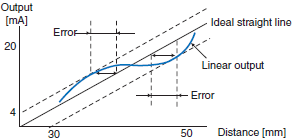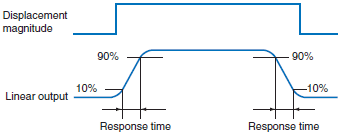Displacement Sensors / Measurement Sensors
|
|
Features |
|
|
Classifications |
| Engineering Data |
|
| Explanation of Terms | Troubleshooting |
Resolution
This is the width, expressed in terms of the distance, of the fluctuation in the linear output when the measured object is still. The narrower the width of the fluctuation is, the better the resolution is.

Full Scale (F.S.)
"Full scale" indicates the full scope of the measurement range.
For example, full scale for a Sensor with a measurement range of ±10 mm is 20 mm.
Linearity
Error with respect to ideal straight line of linear output.
Normally it is the percentage of the measurement range (full scale: F.S.) and is expressed in the format “[]% F.S.”.
Example: 1% F.S.
Example:
Linearity: ±0.2% F.S.
If F.S. is 20 mm (a measurement range from 30 to 50 mm), the dimensional error is calculated as ±0.2 × 1/100 × 20, or ±40 μm.

Temperature Drift
The amount of variation of linear output with respect to changes in the ambient temperature.
Normally it is the percentage of the measurement range (full scale: F.S.) and is expressed in the format []% F.S./°C.
Example:
0.03% F.S./°C (F.S. = 20 mm)
In this case, the fluctuation in the linear output for each 1°C change in temperature would be ±0.03 × 1/100 × 20, or ±6 μm.
If the ambient temperature changes from 23°C to 55°C, the fluctuation would be ±6 × (55 - 23), or ±192 μm.
Linear Output (Analog Output)
The output of measurement results converted into a current or voltage.

Response Time
Linear output when the displacement and width of the object are changed to steps. In analog output, the time required for 10% to 90% change is expressed in terms of the "response time".

Light-receiving Element
An element used to recognize a laser beam as a signal.
There are various types of light-receiving elements, such as a PSD (position sensitive device), a CCD (charge coupled device), or a CMOS (complementary metal oxide semiconductor).
Static Resolution
The variation width of measurement values when the object and Sensor are stationary.
These variations are primarily caused by fluctuations due to noise inside the Sensor or controller.
Moving Resolution
The variation width of measurement values when a flat object or the Sensor itself is moving.
The variations occur due to fluctuations caused by the surface of the object during measurement in motion.
The moving resolution is smaller for objects with an even surface such as mirrors or glass, which results in measurements close to the static resolution. The moving resolution increases for objects with a rough surface (dispersion workpieces) or objects with a surface that affects the amount of laser light reflected (light-absorbing workpieces). When compared with the static resolution, the moving resolution will be 10 or more times lower depending on the object.
Impedance
The AC resistance when an AC current is applied to a circuit.


